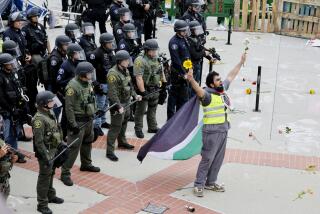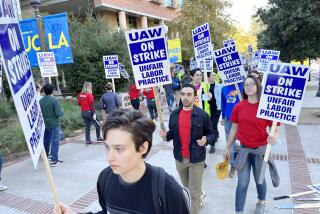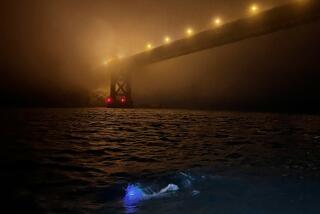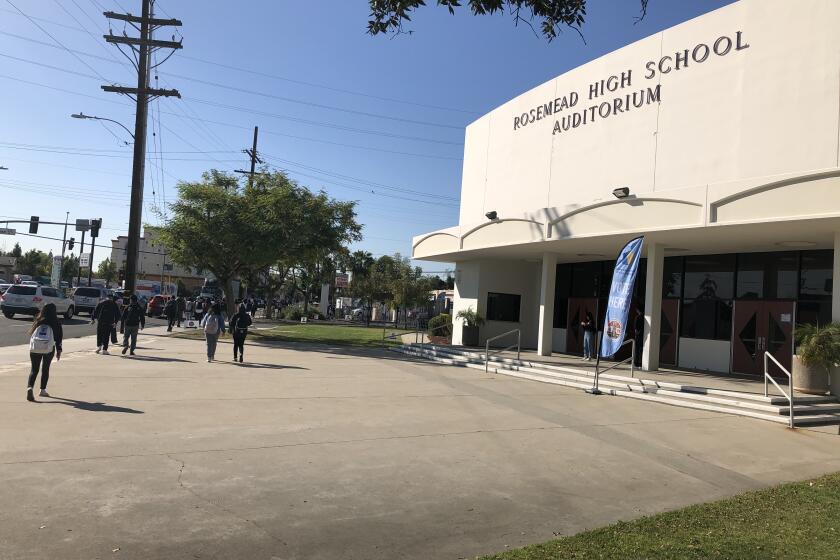Search Parties
At Rancho Santa Margarita Intermediate School, one class uses volumes of the Encyclopaedia Britannica as paperweights.
Here, kids who want to use an encyclopedia turn on one of the school’s 275 computers and connect to Britannica Online via the Internet. Finding information is as quick as typing in a keyword, and the articles, though somewhat abbreviated, are updated monthly.
The question of whether the Internet has a place in schools is already settled, says Principal Robert W. McQueen, an educator for 39 years.
“It’s here, and it’s going to replace a lot of traditional sources of information. I really question how many encyclopedias we need now. We’re training our kids to look up everything on the Internet. It makes accessible a broader range of research, and it’s much quicker and much more current.
“At the same time, the students are learning how the Internet works. It is going to be a part of their lives as they grow.”
Actually, it is already a part of their lives. A national poll last March found that 24% of Americans have Internet access. But at McQueen’s school, a survey last month showed that 72% of students have computers at home and 48% are connected to the Internet.
“At one time,” says McQueen, “if you were a good parent, you got your kids a typewriter and a set of encyclopedias to help them be good students. Now you get them a computer and an Internet hookup. I’m buying computers for my grandchildren.”
Kim Preston’s third-grade classroom at Foothill Ranch Elementary School has the traditional touches: a flag by the door, class rules posted on the bulletin board (“Keep your hands, feet and objects to yourself”), a pencil sharpener mounted on the wall.
It also has something very modern, a huge TV monitor that displays whatever Preston calls up from the Internet. But it does not wow these kids.
In this school district, Saddleback Valley Unified, technology has been embraced with such gusto that it is one of the best-wired school districts around. Many other districts--lacking the funding for equipment or the determination to make it a priority--by comparison have only scratched the surface.
In the Saddleback district, students start using computers and the Internet in kindergarten. By the time they reach Preston, they already know how to write on a computer, although they are more likely to call it word processing.
Of her 28 students, 24 have computers at home. Little wonder then that among the answers to one homework question (What is a memory?) were two defining it as a place where a computer temporarily stores information. “I never got that one before,” Preston says.
In the third grade, the students for the first time use the Internet to seek specific information. Last year when Preston’s class researched whales, she gave them outlines of the information they needed. The students used the school’s library, public libraries and a computerized encyclopedia--but they also went onto the Internet.
There they found the very latest information on whale populations and migrations. Another class “adopted” a specific whale and checked the Internet daily for the whale’s location.
“The library is not obsolete, absolutely not,” Preston says. “We still do the book work because they need to look up information there too.”
But on the Internet, “the information is current and right at their fingertips. Things come to life; they’re animated, and you can hear sounds. We got information on Mars and Mercury that wasn’t in books yet. It is truly thrilling.”
But the Internet requires the ability to judge the reliability of information, so Preston does the judging. She works with small groups of students and is the only one working the keyboard.
“I monitor everything,” she says. “There’s too much out there. You need to screen it for third-grade readability.”
Punch in “Amazon,” for example, and you get a list of hundreds of information sources--universities, governmental agencies, corporations and individual aficionados.
From the list, you can call up and copy satellite photos of the Amazon Basin, perfect for a third-grade report. But also available are “Tropical Aquatics in the Amazon Basin” from the University of Oregon, a bit too arcane. Also “An amazon babe in the nude” from Playline, what educators call “inappropriate.”
But by the time students reach Pat Downey’s sixth-grade class, they are working more independently on the Internet. Under Downey’s eye, they do their own Internet searches and appraise the worth of information they find.
If they stumble onto any amazon babes, they are expected to back away. Not only is Downey watching, so is the computer. It blocks out known “inappropriate” sites and records where each student is spending his or her Internet time. The school district Internet rules are specific. Violate them and students lose their school Internet access forever.
It’s really not a problem, Downey says. By and large, kids are serious about their research.
“We had a project on India and were told our textbook chapter wasn’t quite accurate. So we divided the chapter into topics, and they had to find two sources to verify or refute the facts in the chapter.
“My goal is to make them understand that everything you find may not be accurate. The kids found information they didn’t think was good at all. They just tossed it out.”
Her students do not automatically go to the computer for information, Downey says.
“They’ve gotten to where they like working on the computer because of what they can do with it. By the time they get to me, they see it as a tool. Adults are still a little in awe of computers, but not the kids.”
*
The Internet still makes teacher Mike Mattos a little edgy. For about 18 months he’s had Internet access into his seventh-grade world history classroom at Rancho Santa Margarita Intermediate School.
“I’m not Mr. Techie. It’s so easy to find pornography over the Internet, so I’ve been careful.”
What he finds remarkable is that given his reservations, the Internet still takes up a large part of his class time. Every Friday he takes his class on an Internet “field trip” by displaying the pictures and sounds of far-off places, such as the Sahara desert or the United States Holocaust Memorial Museum in Washington.
The class sends e-mail to the White House and gets a quick, if automated, reply. E-mail to Bosnia brought that conflict to life for the class.
“I’ve not reached a point yet where I have confidence. But they need Internet access. And I have to admit, I’ve never seen a student misuse it. This year we’ll be moving toward more independent work.”
Paul Hart, who teaches physics and chemistry to eighth-graders, has left his reservations far behind. He has one computer terminal in his classroom, “and I wish I had five.”
“Students can call up UCI, the San Francisco Exploratorium and can have things demonstrated with animation and sound,” Hart said. “You don’t get that out of an encyclopedia.”
When Hart’s class was building bridges out of toothpicks, a student discovered a school in Boston that was doing the same project. “This class in Boston demonstrated what they’d tried and what didn’t work. My kids started e-mailing them.”
And the Internet is especially valuable for its current information, Hart says. “A lot of the stuff on the Internet is brand new. We did a project on the ebola outbreak in Africa. That information was only hours old.”
*
Eighth-graders Hotan Faraji and Nick Hambarian explained how they researched their computerized report on Vikings last year at Rancho Santa Margarita Intermediate School.
Hotan: “We had books, but the Internet had better information.”
Nick: “You just look in the yellow pages [a book listing Internet sources] under ‘Vikings.’ It’s modern. Books may be 2 or 3 years old. If they find a new dinosaur in Africa, you can find out about it.”
Hotan: “You can get more than one source.”
Adds Mike Provence, another eighth-grader: “There’s a lot more variety. There are at least 100,000 [Internet sources]. You can go to reliable sources, like the big museums in Washington. I used the Library of Congress for [a project on] Gen. Grant. They had pictures I could download and use.”
To find nearly anything on the Internet, “you type in a couple of words, and there it is. In the library, you have to look up books and then try to find 926.457 or something.”
The three boys were at a table in the school’s library, where much less space is devoted to bookshelves than in traditional libraries. To one side is a bank of computers for Internet research, and in an adjoining room is one of two computer labs. Each contains 32 computers for Internet research and for instruction in how to use computers and the Internet.
The school opened in 1993 with its full inventory of 275 computers, 72 of them laptops that can be carted into classrooms when the entire class needs a computers.
“This school has been recognized several times for being technologically advanced,” says McQueen, the principal. “But we still have to call the teachers together and examine what and how we teach computer skills. We have to work to keep ahead of the kids who come up from elementary school.”
2 Compared to the newer elementary and intermediate schools in the district, where computer wiring was built in, the older high schools are just getting acquainted with the Internet. Installing equipment in the older buildings is a bigger, more expensive task.
At Laguna Hills High School, a computer room off the library is about to open with 40 computers. And some classrooms have had hookups for a year or so.
Teacher Karen Alms uses her Internet connection to bring her German classes to life.
“It’s one thing to practice talking to each other in class. It’s a gigantic leap to send e-mail to other kids in German. We have a link to a school in Berlin. It makes it ever so much more interesting. The old pen-pal system always took too long to establish a real correspondence.”
Alms’ students plan trips to German-speaking nations using the latest information available on the Internet. They call up German newspapers and read about current events written in German for Germans. “It’s all authentic and up to date.”
*
But few use the Internet as intensely as the students in Clay Sisman’s Model United Nations class. The program for honors students teaches comparative government by having the students “adopt” nations, study them and prepare position papers for Model United Nations conferences.
For Sisman, the Internet has been a boon, giving his students access to real U.N. documents only hours after they are approved and to news media sources worldwide.
“It is new and fun, but it also gives you access to things you wouldn’t otherwise find,” Sisman says. “It will change my courses big time, but keep in mind, the students are still writing and still reading. We’re never going to do away with hard-copy media. The Internet is just a different way of doing it.”
Already the Internet has become so important in Sisman’s class that veteran students are appointed to train new students how to use it. One is Chris Jue-Steuck, a junior who is one of the class’ four undersecretaries-general for computer resources and the Internet.
“It’s a necessity,” Chris says. “If you don’t use the Internet, you’re going to do really badly. Maybe 95% of the information we need comes from the Internet.”
To demonstrate, he searched the net for references to “Bosnia” and in a few seconds received about 12,000 listings, including: a concert to benefit Bosnia, U.N. reports, CARE reports, a paper on telemedicine in Bosnia, a newsletter for U.S. troops in Bosnia, a daily newsletter by U.N. forces in Bosnia, a New York Times article, somebody’s snapshots taken in Bosnia and Army maps and charts of Bosnia.
“Basically, you just go to places that you know are going to have good information--universities, institutions, organizations,” Chris says. “It’s really amazing what you get when you search.”
(BEGIN TEXT OF INFOBOX / INFOGRAPHIC)
INTERNET FOR STUDENTS
Here are some of the Internet sources used by students in the Saddleback Valley Unified School District. The complete list is available via Internet at https://www.svusd.k12.ca.us/Curriculum/Grade%20level.htm
Grades 1-3
* Butterflies--Articles on conservation, migration and raising of butterflies from Hole-in-Hand Butterfly Farm, Hazelton, Pa.: https://mgfx.com/butterfly
* Internet Public Library--Illustrated stories, fun with science and math, reading “room” and kids’ newsletter from the University of Michigan’s library school: https://ipl.sils.umich.edu/youth/HomePage.html
* Learning Center--Materials and activities in language, math and social science from publisher Houghton Mifflin: https://www.hmco.com/hmco/school
* Storytelling--List of sources for fairy tales, folk tales and children’s stories from Swarthmore College: https://www.swarthmore.edu:80/sjohnson/stories
Grades 4-6
* Egypt--Exhibits and virtual tour from University of Memphis, Tenn., Institute of Egyptian Art and Archaeology: https://www.memst.edu/egypt/main.html
* Electronic Zoo--Huge list of sources, including images and sounds, on animals and veterinary medicine from Washington University, St. Louis, Mo.: https://netvet.wustl.edu/ssi.htm
* Indians--The California Indian Library Collections from UC Berkeley: https://www. mip.berkeley.edu/cilc/brochure/brochure.html
* Space Shuttle--Information, updates and images from NASA: https://shuttle.nasa.gov
* Tornadoes--Explanations, statistics and bibliography from a high-school freshman in Logan, Utah: https://cc.usu.edu/kforsyth/Tornado.html
Grades 7-8
* American Revolution--Timeline of the Revolutionary War from Columbia University, New York: https://www.ilt.columbia.edu/k12/history/timeline.html
* Astronomy--Images from the Hubble Space Telescope: https://quest.arc.nasa.gov/hst/index.html
* Hands-On Science--Demonstrations with images and sound from the San Francisco Exploratorium: https://www.exploratorium.edu
* Pizza Math--Concoct a virtual pizza, then analyze sizes and costs for practice in geometry and math: https://www.cs.rice.edu/sboone/Lessons/Titles/pizza.html
* Solar System--Images and information from the Los Alamos (N.M.) National Laboratory: https://bang.lanl.gov/solarsys/homeold.htm
Grades 9-12
* Africa--Maps from the CIA: https://www.sas.upenn. edu/African--Studies/CIA--Maps/menu--CIA.html
* Bosnia--A virtual field trip conducted by George Mason University, Fairfax, Va.: https://geog.gmu.edu/gess/jwc/bosnia/bosnia.html
* Foreign Languages--List of Internet resources for many foreign languages, compiled at Bethel High School in Hampton, Va.: https://www.bethel.hampton.k12.va.us/langlink.html
* Reference--Full-text reference sources from Carnegie Mellon University, Pittsburgh: https://english-www.hss.cmu.edu/reference
* Theater--Listings of and information for theatrical professionals from Theatre Central: https://www.theatre-central.com
More to Read
Start your day right
Sign up for Essential California for news, features and recommendations from the L.A. Times and beyond in your inbox six days a week.
You may occasionally receive promotional content from the Los Angeles Times.






